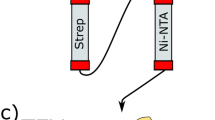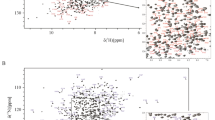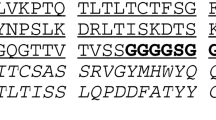Abstract
Monoclonal antibody (mAb) drugs are clinically important for the treatment of various diseases. TTAC-0001 is under development as a new anti-cancer antibody drug targeting VEGFR-2. As the less severe toxicity of TTAC-0001 compared to Bevacizumab, likely due to the decreased in vivo half-life, seems to be related to its structural flexibility, it is important to map the exact flexible regions. Although the 13C/15N-labeled protein is required for NMR analyses, it is difficult to obtain antibody fragments (Fab and scFv) containing disulfide bonds through general cytosolic expression in Escherichia coli (E. coli). Here, we notably increased the periplasmic expression of the 13C/15N-labeled TTAC-0001-Fab (13C/15N-TTAC-Fab) through simple isopropyl β-D-1-thiogalactopyranoside (IPTG)-induction at an increased optical density (1.5 OD600nm). Through NMR triple resonance experiments, two loop insertions (LI-1 between the VH and CH1; LI-2 between the VL and CL) were confirmed to be highly flexible. The additional LIs could be another way to engineer the antibody by changing the pharmacokinetic properties.




Similar content being viewed by others
References
Arbogast LW, Brinson RG, Marino JP (2015) Mapping monoclonal antibody structure by 2D 13C NMR at natural abundance. Anal Chem 87:3556–3561
Chames P, Van Regenmortel M, Weiss E, Baty D (2009) Therapeutic antibodies: successes, limitations and hopes for the future. Br J Pharmacol 157:220–233
Cher L, Nowak AK, Iatropoulos G, Lee WS, Lee SY, Shim SR, Yoo JS (2017) ACTR-75. A multicenter, 3-arm, open-label, phase IIa clinical trial to evaluate safety and efficacy of Tanibirumab (VEGFR2 mAB), in patients with recurrent GBM assessed with K-trans and initial area under the gadolinium concentration-time curve (IAUGC). Neuro Oncol 19(Suppl 6):17
Dall'Acqua WF, Cook KE, Damschroder MM, Woods RM, Wu H (2006) Modulation of the effector functions of a human IgG1 through engineering of its hinge region. J Immunol 177:1129–1138
De Simone A, Cavalli A, Hsu ST, Vranken W, Vendruscolo M (2009) Accurate random coil chemical shifts from an analysis of loop regions in native states of proteins. J Am Chem Soc 131:16332–16333
Delaglio F, Grzesiek S, Vuister GW, Zhu G, Pfeifer J, Bax A (1995) NMRPipe: a multidimensional spectral processing system based on UNIX pipes. J Biomol NMR 6:277–293
Duff AP, Wilde KL, Rekas A, Lake V, Holden PJ (2015) Robust high-yield methodologies for (2)H and (2)H/(15)N/(13)C labeling of proteins for structural investigations using neutron scattering and NMR. Methods Enzymol 565:3–25
Elice F, Rodeghiero F (2012) Side effects of anti-angiogenic drugs. Thromb Res 129(Suppl 1):S50–53
Gaciarz A, Khatri NK, Velez-Suberbie ML, Saaranen MJ, Uchida Y, Keshavarz-Moore E, Ruddock LW (2017) Efficient soluble expression of disulfide bonded proteins in the cytoplasm of Escherichia coli in fed-batch fermentations on chemically defined minimal media. Microb Cell Fact 16:108
Garcia AE, Sanbonmatsu KY (2002) Alpha-helical stabilization by side chain shielding of backbone hydrogen bonds. Proc Natl Acad Sci USA 99:2782–2787
Geng X, Kong X, Hu H, Chen J, Yang F, Liang H, Chen X, Hu Y (2015) Research and development of therapeutic mAbs: an analysis based on pipeline projects. Hum Vaccines Immunother 11:2769–2776
Green ER, Mecsas J (2016) Bacterial secretion systems: an overview. Microbiol Spectr 4:213–239
Harrison JS, Keshavarz-Moore E (1996) Production of antibody fragments in Escherichia coli. Ann N Y Acad Sci 782:143–158
Hess B, Kutzner C, van der Spoel D, Lindahl E (2008) GROMACS 4: algorithms for highly efficient, load-balanced, and scalable molecular simulation. J Chem Theory Comput 4:435–447
Jeliazkov JR, Sljoka A, Kuroda D, Tsuchimura N, Katoh N, Tsumoto K, Gray JJ (2018) Repertoire analysis of antibody CDR-H3 loops suggests affinity maturation does not typically result in rigidification. Front Immunol 9:413
Kay LE, Gardner KH (1997) Solution NMR spectroscopy beyond 25 kDa. Curr Opin Struct Biol 7:722–731
Kessler N, Zvi A, Ji M, Sharon M, Rosen O, Levy R, Gorny M, Zolla-Pazner S, Anglister J (2003) Expression, purification, and isotope labeling of the Fv of the human HIV-1 neutralizing antibody 447–52D for NMR studies. Protein Expr Purif 29:291–303
Kim DG, Jin Y, Jin J, Yang H, Joo KM, Lee WS, Shim SR, Kim SW, Yoo J, Lee SH et al (2015) Anticancer activity of TTAC-0001, a fully human anti-vascular endothelial growth factor receptor 2 (VEGFR-2/KDR) monoclonal antibody, is associated with inhibition of tumor angiogenesis. mAbs 7:1195–1204
Kim J, Choi D, Park C, Ryu KS (2017) Backbone resonance assignments of the Escherichia coli 62 kDa protein, Hsp31. Biomol NMR Assign 11:159–163
Kovermann M, Rogne P, Wolf-Watz M (2016) Protein dynamics and function from solution state NMR spectroscopy. Q Rev Biophys 49:e6
Krishnarjuna B, Sugiki T, Morales RAV, Seow J, Fujiwara T, Wilde KL, Norton RS, MacRaild CA (2018) Transient antibody-antigen interactions mediate the strain-specific recognition of a conserved malaria epitope. Commun Biol 1:58
Lee W, Tonelli M, Markley JL (2015a) NMRFAM-SPARKY: enhanced software for biomolecular NMR spectroscopy. Bioinformatics 31:1325–1327
Lee WS, Pyun BJ, Kim SW, Shim SR, Nam JR, Yoo JY, Jin Y, Jin J, Kwon YG, Yun CO et al (2015b) TTAC-0001, a human monoclonal antibody targeting VEGFR-2/KDR, blocks tumor angiogenesis. mAbs 7:957–968
Lee SJ, Lee SY, Lee WS, Yoo JS, Sun JM, Lee J, Park SH, Park JO, Ahn MJ, Lim HY et al (2017) Phase I trial and pharmacokinetic study of tanibirumab, a fully human monoclonal antibody to vascular endothelial growth factor receptor 2, in patients with refractory solid tumors. Invest New Drugs 35:782–790
Liu JK (2014) The history of monoclonal antibody development: progress, remaining challenges and future innovations. Ann Med Surg 3:113–116
Liu L (2018) Pharmacokinetics of monoclonal antibodies and Fc-fusion proteins. Protein Cell 9:15–32
Liu D, Ren D, Huang H, Dankberg J, Rosenfeld R, Cocco MJ, Li L, Brems DN, Remmele RL Jr (2008) Structure and stability changes of human IgG1 Fc as a consequence of methionine oxidation. Biochemistry 47:5088–5100
Lobstein J, Emrich CA, Jeans C, Faulkner M, Riggs P, Berkmen M (2012) SHuffle, a novel Escherichia coli protein expression strain capable of correctly folding disulfide bonded proteins in its cytoplasm. Microb Cell Fact 11:56
Nelson AL, Dhimolea E, Reichert JM (2010) Development trends for human monoclonal antibody therapeutics. Nat Rev Drug Discov 9:767–774
Pettersen EF, Goddard TD, Huang CC, Couch GS, Greenblatt DM, Meng EC, Ferrin TE (2004) UCSF Chimera: a visualization system for exploratory research and analysis. J Comput Chem 25:1605–1612
Reddy PT, Brinson RG, Hoopes JT, McClung C, Ke N, Kashi L, Berkmen M, Kelman Z (2018) Platform development for expression and purification of stable isotope labeled monoclonal antibodies in Escherichia coli. mAbs 10:992–1002
Vashist SK (2012) Comparison of 1-ethyl-3-(3-dimethylaminopropyl) carbodiimide based strategies to crosslink antibodies on amine-functionalized platforms for immunodiagnostic applications. Diagnostics 2:23–33
Ward ES, Gussow D, Griffiths AD, Jones PT, Winter G (1989) Binding activities of a repertoire of single immunoglobulin variable domains secreted from Escherichia coli. Nature 341:544–546
Yang J, Yan R, Roy A, Xu D, Poisson J, Zhang Y (2015) The I-TASSER Suite: protein structure and function prediction. Nat Methods 12:7–8
Acknowledgements
This research was supported by a Grant from the Korea Basic Science Institute (T39632 to K.S.R.) and by a Grant from the National Research Foundation of Korea (2016R1A2B4015436 to K.S.R.). Additionally, this work was supported, in part, by the Samsung Science & Technology Foundation (SSTF-BA1701-10 to J.W.L.).
Author information
Authors and Affiliations
Corresponding authors
Ethics declarations
Conflict of interest
The authors declare no competing interests.
Additional information
Publisher's Note
Springer Nature remains neutral with regard to jurisdictional claims in published maps and institutional affiliations.
Electronic supplementary material
Below is the link to the electronic supplementary material.
Rights and permissions
About this article
Cite this article
Cha, S., Lee, W.S., Choi, J. et al. NMR mapping of the highly flexible regions of 13C/15N-labeled antibody TTAC-0001-Fab. J Biomol NMR 74, 311–319 (2020). https://doi.org/10.1007/s10858-020-00313-1
Received:
Accepted:
Published:
Issue Date:
DOI: https://doi.org/10.1007/s10858-020-00313-1




